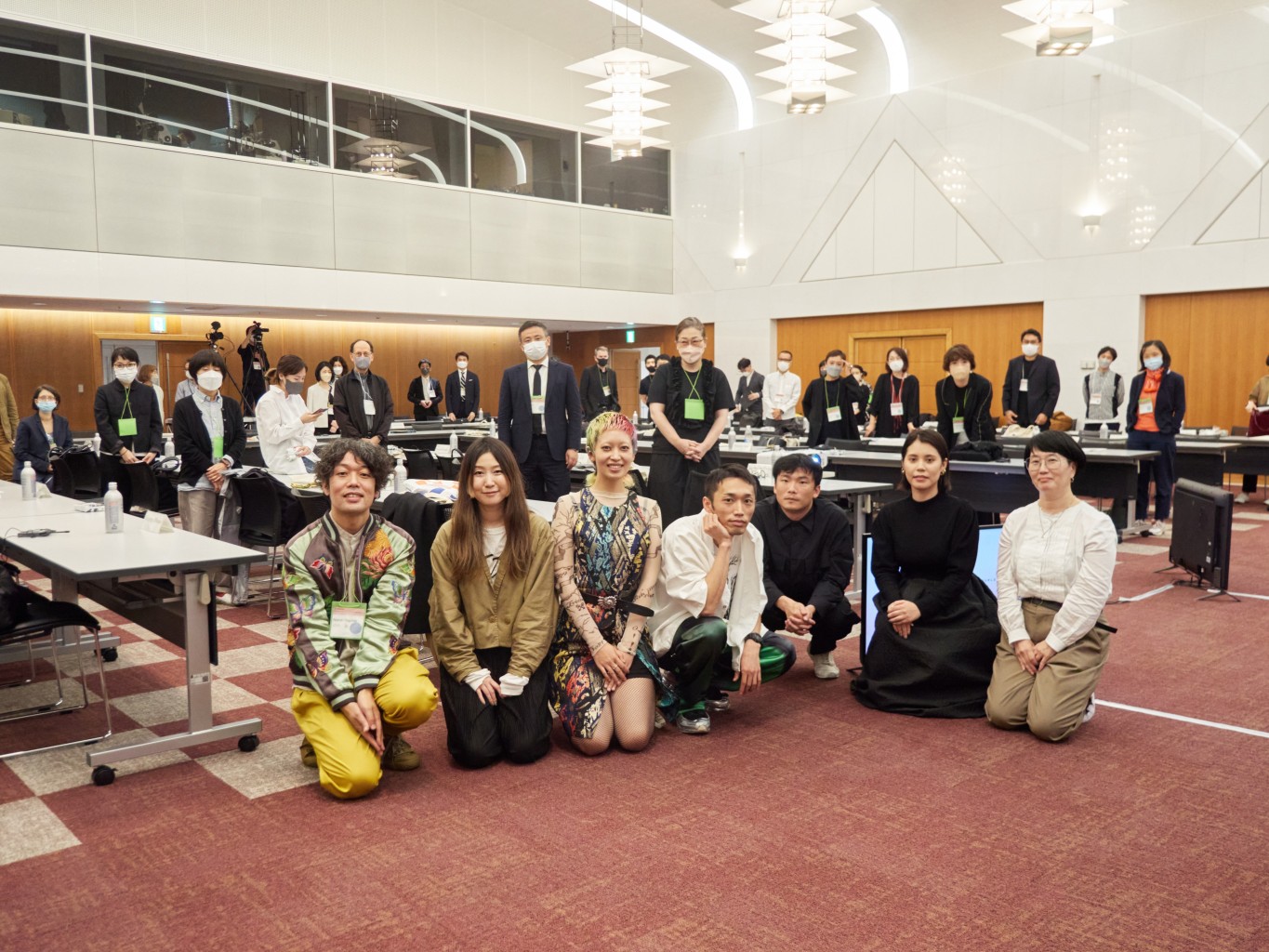Art writer and editor. She also works as an art coordinator in many exhibitions and projects. The editorial staff of RealTokyo.
The Bunka-cho Art Platform Japan project was launched in 2018 to promote contemporary Japanese art and raise its international profile. One of the core programs of the project is the Bunka-cho Contemporary Art Workshop, an effort to create an international network of experts involved in contemporary art in Japan and overseas. The fourth edition of the workshop was held at the Aichi Arts Center over three days. As it aims to establish a “face-to-face” network, how has the project gone about building trust and networks while dealing with the impact of Covid-19? The following is our report on the workshop.
Session 1: New Networks in the Asia-Pacific Region
Moderators: Uematsu Yuka (Chief Curator, The National Museum of Art, Osaka)
Presenters:
Pi Li (Senior Curator, M+)
Park Joowon(Curator, National Museum of Modern and Contemporary Art, Korea [MMCA]
Furuichi Yasuko (Former Art Coordinator, the Japan Foundation Asia Center)
Session 1 reviewed the five years of the Art Platform project, with presentations given by Pi Li (then of M+) in Hong Kong and Park Joowon of the MMCA in Korea, who spoke about the characteristics and principles of art museums in the Asia-Pacific region that have opened or been expanded in the past five years. In the latter half of the session, Furuichi Yasuko, formerly of the Japan Foundation Asia Center and now a freelancer, joined the discussion, reviewing the Japan Foundation’s longstanding exchange programs between Japan and the rest of Asia. The participants then exchanged views on the new international networks being formed in the Asia-Pacific region.
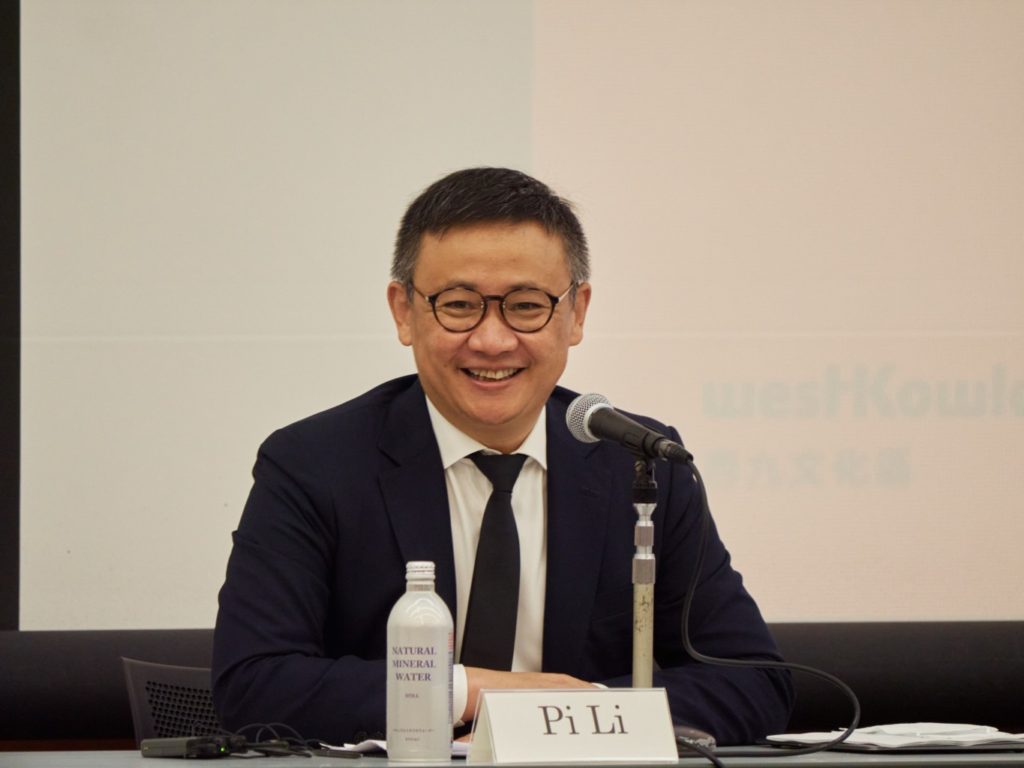
Hong Kong’s M+: the first global museum in Asia
Pi Li (Senior Curator, M+)
M+, Asia’s first global museum of visual culture, opened in Hong Kong in November 2021. The city’s new landmark boasts 33 galleries across its 18-story, 65,000-square-meter building and has already welcomed some 1.5 million visitors.
Discussing the background of the museum’s establishment, Pi Li, Senior Curator and Head of Curatorial Affairs at M+, noted how new cultural facilities were set up in Hong Kong one after the other in the late 1990s, a historical turning point for the city with its return to China in 1997, and that M+ is part of this process, having been conceived by the local government in 1998 as part of the West Kowloon Cultural District. Amidst intensifying globalization, developments such as the launch of Art Basel Hong Kong in 2013 and the opening of several major cultural facilities in renovated industrial heritage sites have made Hong Kong the most important hub for art in Asia, where local and international art intersect. It was in such a context that M+, Asia’s first global museum, opened its doors in 2021. Pi emphasized that M+ is built on the distinctive historical and geographical conditions of the city of Hong Kong.
M+, whose name stands for “more than a museum,” takes as its focus the collection, exhibition, and archiving of the visual culture of the 20th and 21st centuries, encompassing not only visual art but also design and architecture. The collection covers Hong Kong, mainland China, and the rest of Asia and beyond, with a collection of 6,413 art works and an archive of 48,000, including architectural designs, as of December 2021. Most of the Chinese art was donated by the Swiss collector Uli Sigg. The opening exhibition consisted of six thematic displays based on the M+ collection.
What does “international” mean in the context of an “international museum?” Pi explained M+’s concept of the international by introducing the six parts of the opening exhibition one by one.
“Hong Kong: Here and Beyond” Hong Kong’s local culture, including architecture, design, film, and games, with a spotlight on its global connections
“M+ Sigg Collection: From Revolution to Globalization” A chronological overview of contemporary Chinese art from the 1970s to the 2000s
“Dream of the Museum” An exhibition of conceptual art examining the intersection of East and West, centered on the works of Marcel Duchamp, John Cage, Nam June Paik, and Yoko Ono, who influenced each other both publicly and privately
“Asian Field” Special exhibition of an installation of clay figures created by British artist Antony Gormley with villagers in Guangdong Province, marking the work’s first public display in 20 years
“Things, Spaces, Interactions” Architecture and design
“Individuals, Network, Expression” An exhibition of contemporary Asian art and its networks from the postwar period to the age of globalization, displayed across eight galleries
All exhibitions were ambitious in their attempts to parse the complex web of patterns drawn by contemporary and art history not only in Hong Kong and China but across Asia as a whole. Also strongly felt throughout the introduction of M+’s politically charged commission work was a dynamism fitting for a global museum, where the local and international intersect and interrelate. “The role of M+ is to identify new patterns and trends in the dynamic field of contemporary art, and to examine and introduce them based on solid history.” (Pi Li)
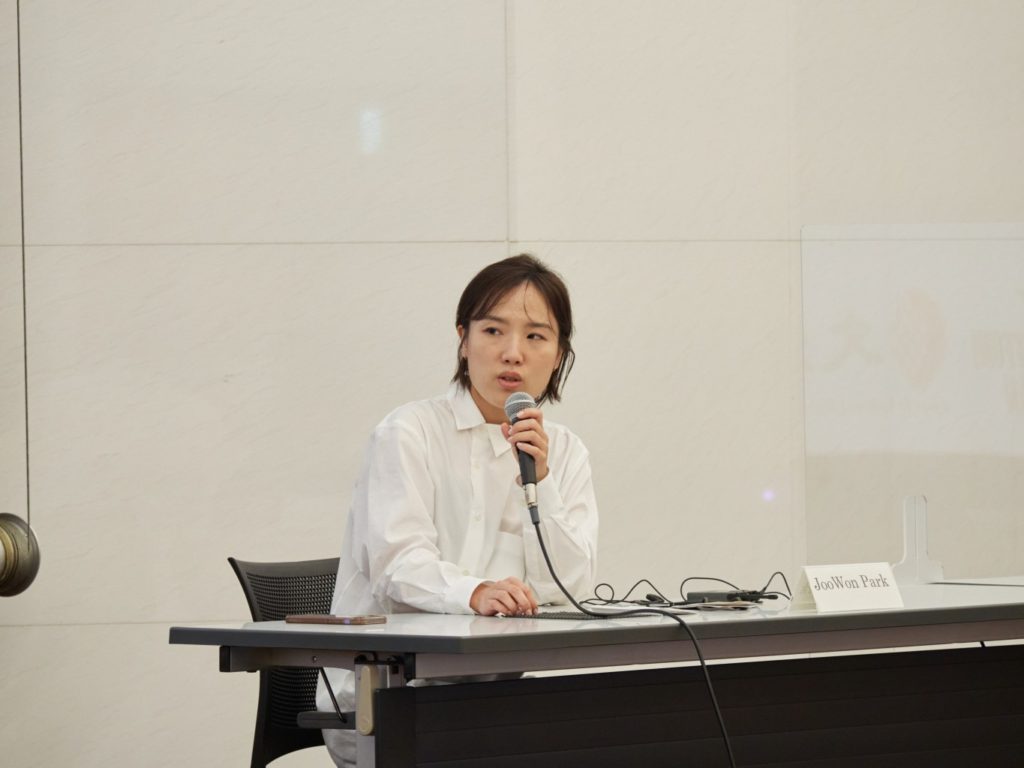
MMCA Seoul: its mission as a public museum and the challenges of the Asia Project
Park Joowon (Curator, National Museum of Modern and Contemporary Art, Korea)
Established in 1969, the National Museum of Modern and Contemporary Art, Korea, known by its initials MMCA, comprises four branches that each have distinct characteristics. MMCA Deoksugung specializes in modern art, Gwacheon is a research and archival center in the midst of nature, and Cheongju functions as a storage center where the public can observe conservation and restoration work. And then there is MMCA Seoul, which is an open, international museum in the center of Seoul. Park Joowon is a curator at MMCA Seoul and leads the museum’s biennial Asia Project.
According to Park, the MMCA as a national institution is always asking itself questions regarding its role as a public art museum. He described the institution’s mission as follows: “In Seoul, where you have to pay to have space for yourself, the museum must be a place that anyone can visit and where a diverse range of people can come together.” As examples of this, Park introduced exhibitions he organized as part of the Asia Project.
“How Little You Know About Me” kicked off the Asia Project in 2018 by asking “What is Asia?” Food and alcohol were served in MMCA Seoul’s trademark rectangular plaza, creating a space for dialogue over food and drinks.
Held in 2020, “Looking for Another Family” delved into the many facets of “families” unrelated by blood, working together with various artist groups and members of local communities based in East and Southeast Asia. Although the exhibition was cut short by the pandemic, running for only 36 days instead of the planned 93, those days saw viewers freely take notes on their impressions of the exhibition, and conversations emerged organically as a result. Park also recalled that discussing each other’s situations and concerns online during the lockdown with artists based both within and outside Korea was an experience akin to finding a new family.
In 2022, the Asia Project organized a virtual exhibition called “Terracotta Friendship” in collaboration with the 15th edition of Documenta, a contemporary art exhibition held in Kassel, Germany. Four pavilions by artists were set up in the metaverse and an online forum was held.
MMCA Seoul aims to be a place open to all, where people can exchange ideas and inspire each other, and Park said that he would like to see this dynamic work on an international scale.
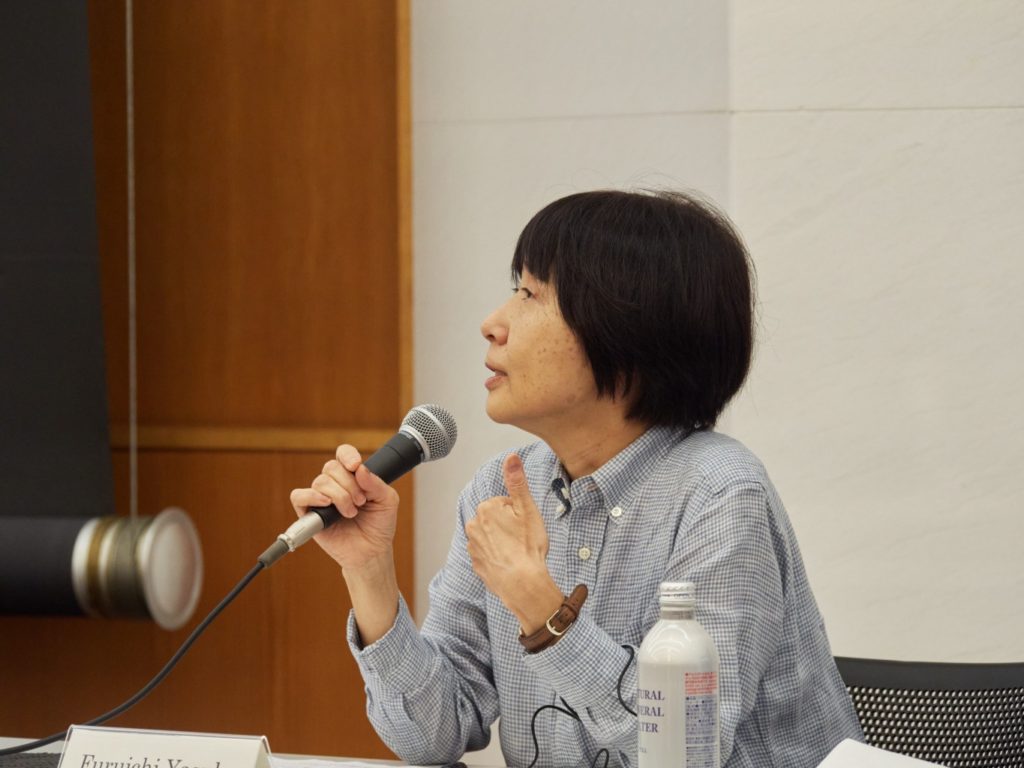
“Imagining New Ecologies—Curatorial Collaboration Projects of The Japan Foundation Asia Center”
Furuichi Yasuko (Former Art Coordinator, the Japan Foundation Asia Center)
Furuichi, a long-time coordinator of Asian art at The Japan Foundation, has been a key figure in the creation of cross-Asian “face-to-face” networks. In 1990, the year she began working at The Japan Foundation, the institution established the Japan Foundation ASEAN Culture Center to promote understanding of the member countries of the Association of Southeast Asian Nations (ASEAN). In 1995, the 50th anniversary of the end of World War II, the center’s geographical coverage was expanded and its name was changed to the Asia Center. It temporarily ceased to exist due to departmental restructuring, but a new Asia Center was once again established, this time for a limited period from 2014 to 2021. Furuichi was in charge of exchange programs in the Asian region throughout that period, bringing many people closer together.
The Japan Foundation Asia Center’s art projects have focused on collaborative efforts, with the goal of promoting two-way rather than one-way artistic exchanges. The first of these projects was “Under Construction,” which was planned and implemented between 2000 and 2003 and in which the young Pi Li participated. Curators from China, India, Indonesia, Japan, Korea, the Philippines and Thailand worked together to explore the theme “What is Asia?,” collaborating on everything from local to comprehensive exhibitions, with this process itself materialized as a project. Furuichi noted that the experience of having collaborated in the early 2000s, when it was still difficult to obtain information about each other, was valuable and has contributed to subsequent networking in Asia. Although “Under Construction” was undeniably a Japan-centered program, ending with a general exhibition in Tokyo, “Condition Report,” held from 2015 to 2018, began and ended in various parts of Southeast Asia, with Japanese participation. This program reflected the contemporary geopolitical power balance between Japan and Southeast Asian countries, capturing an era in which Japan and the other Asian countries stand on the same platform. Furuichi argued that it will be important for the future cultural policy of Japan to take the context of Asia into account.
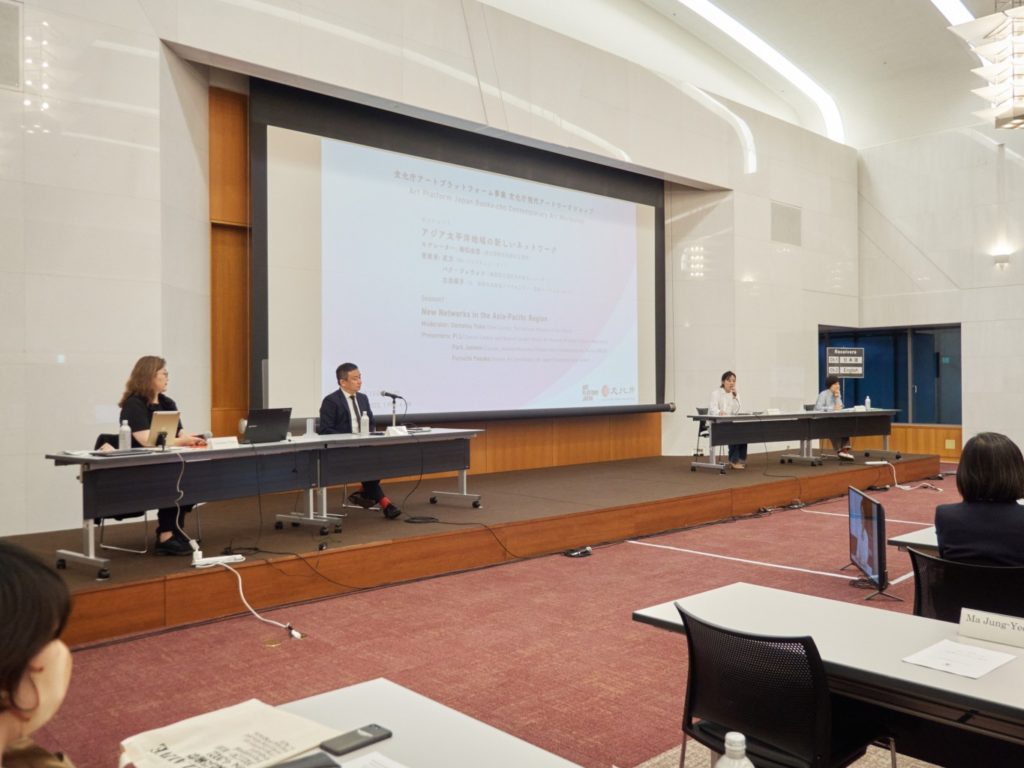
Discussion by presenters and moderator
Park said it was noteworthy that young Asian curators in their 20s and 30s shared an interest in the theme of Asian identity in the early 2000s. For Furuichi, there is no single correct answer to the question, “What is Asia?” She argued that one’s own idea of “Asia” can be found in the process of forming relationships among people. Park agreed, stating that bringing together different stories and expressing them to each other is to raise the question of Asia within the museum, and that no matter the era, participants’ images of Asia will emerge as they strive in the same direction by building relationships.
On the other hand, in response to a question about the formation of M+’s international collection, Pi noted that the positioning of Chinese art in the collection has been a subject of ongoing debate, and that the opening exhibition aimed to deconstruct the national context and to study and present the genealogy of art after World War II. Uematsu, who is involved in international acquisitions at the National Museum of Art, Osaka, agreed, saying that what matters is not the nationality of the artist, but the type of work itself, its meaning, and the way it is incorporated into the museum’s narrative once acquired.
Session 2: Artist Presentations
Moderators: Odate Natsuko (Arts Commons Tokyo, Yoshiko Isshiki Office), Nariai Hajime (Curator, Department of Fine Arts, The National Museum of Modern Art, Tokyo)
Presenters:
Ana Scripcariu-Ochiai (Artist)
Han Ishu (Artist)
MES (Artist duo)
Momose Aya (Artist)
Session 2 took up the transnational perspective of the Art Platform project, featuring presentations by four artists and artist groups who create cross-disciplinary works using a variety of media, shaking up social stereotypes in response to themes such as gender and national identity.
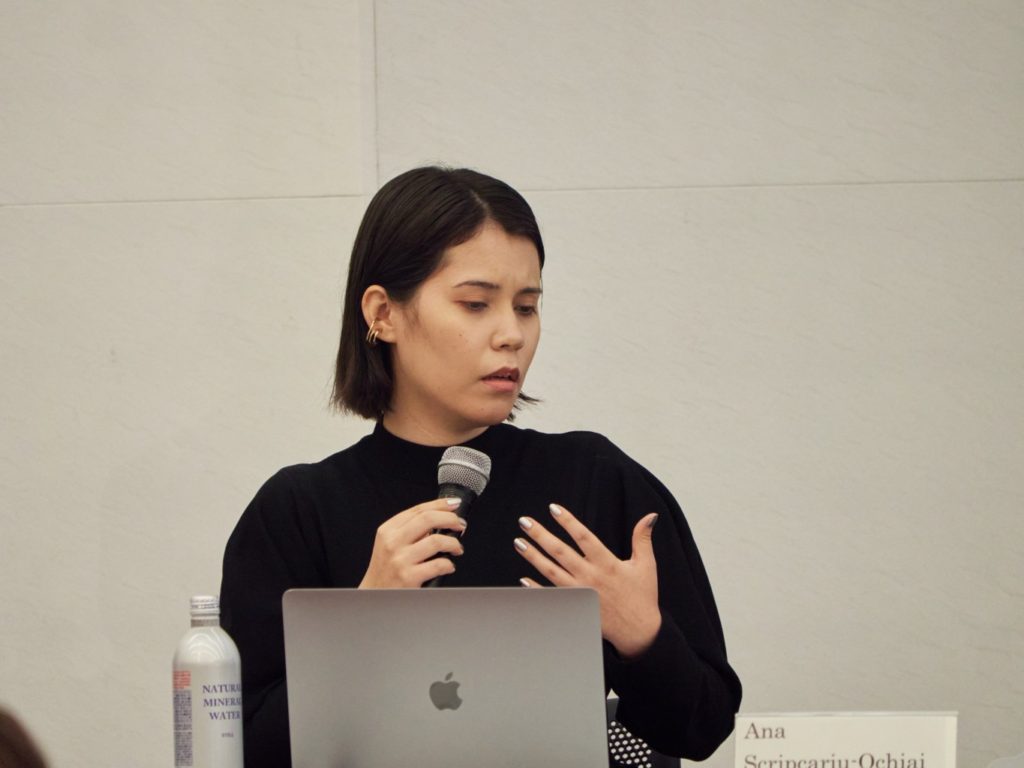
Connections between land and people born out of a distance from motifs
Ana Scripcariu-Ochiai (Artist)
Born in 1992 and a native of two countries, Japan and Romania, Ana Scripcariu-Ochiai’s background has inspired her interest in the connections between land and people. She works across a variety of media including photography, installation, video, painting, and art objects. In the installation “Blessing Beyond the Borders” (2019), exhibited at the Museum of Modern Art, Saitama, she used a double-helix display of photographs documenting traditional Romanian and Japanese festivals and customs to elevate an individual’s interest in their homeland into a universal sensation.
“One’s Final Home” (2019–2021), which won the Meruro Washida Prize of the TERRADA ART AWARD 2021 develops its narrative from a Japanese grave in Hội An, Vietnam, questioning the human condition of belonging through the eyes of the border-crossers of the past. Discussing the process of producing and exhibiting “The Beginning of My Journey is the Beginning of Your Journey” (2021), an exhibition with her mother, who is a photographer, Scripcariu-Ochiai said she felt the difficulty of making her own life and that of her mother the motif of her artwork. However, she also noted that it was precisely because of these challenges that she was able to create a valuable work that marked a milestone in her first chapter as an artist. Scripcariu-Ochiai, who is gradually weaving her own journey of identity into a universal story, will be living and studying in Romania for a year starting in December 2022. She concluded by saying that this would be the beginning of her “second chapter.”
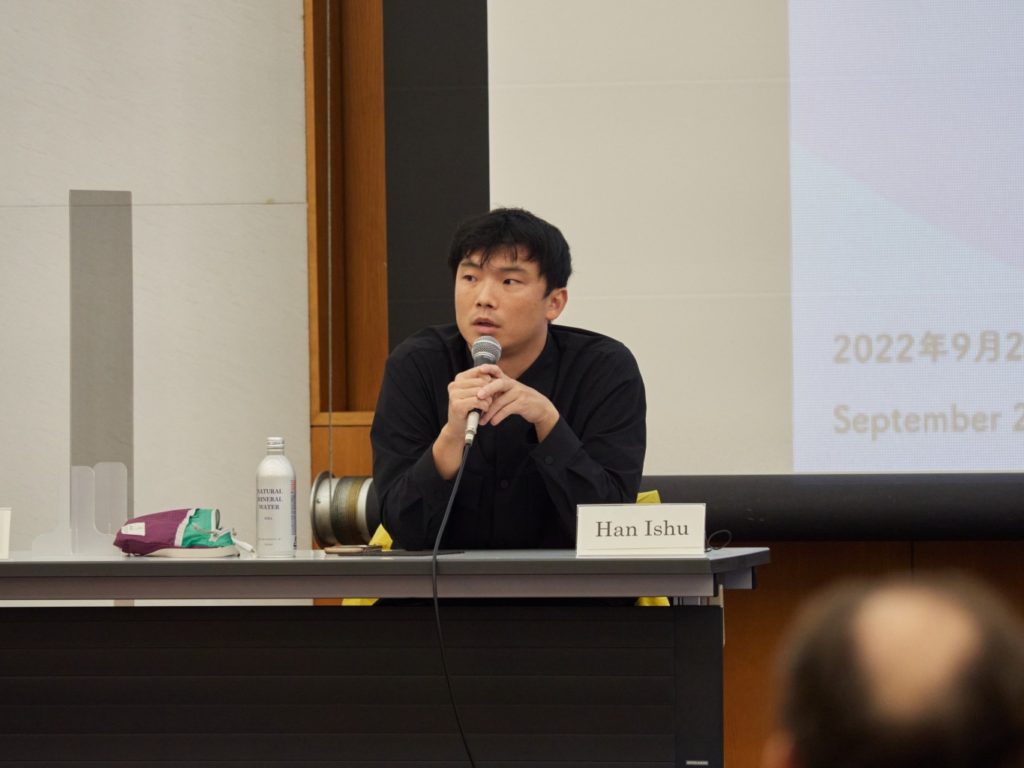
Intervening in landscapes with the body
Han Ishu (Artist)
Han Ishu, who moved from Shanghai to Japan with his family when he was nine years old, began his presentation by screening his 2008 work “White on White,” in which he filmed himself bringing home feathers from ducks that had been kept by relatives in Shanghai and scattering them on the snow in Aomori. The mixture of the white snow of Aomori and the white feathers from Shanghai symbolizes the presence of people from different backgrounds in different lands.
Since early in his career, Han has been creating many video works featuring physical performance. In “A Dream About Stopping the Waves,” born from his experience as a part-time security guard at a concert venue, the artist is shown in the ocean, trying to stop the surging waves while being swept underwater. For “MOT Annual 2021” at the Museum of Contemporary Art Tokyo, Han presented an installation composed entirely of video works featuring him performing alone in the sea. For him, filming such daily, solitary activities “is like keeping a diary.”
Han is interested in how one can build relationships by intervening with one’s own body in the landscape of a place one is visiting for the first time. As the movements of the individual body interact with the landscape, the presence of immigrants and others invisible to society comes into view. “A Bon dancing thread born of dust,” exhibited at the 2022 Aichi Triennale, is a video work that follows a single thread as it drifts through a dusty old factory making the padding used to line obi sashes, poetically depicting the artist’s own gaze as he confronts the time and memories that have accrued in an unfamiliar place.
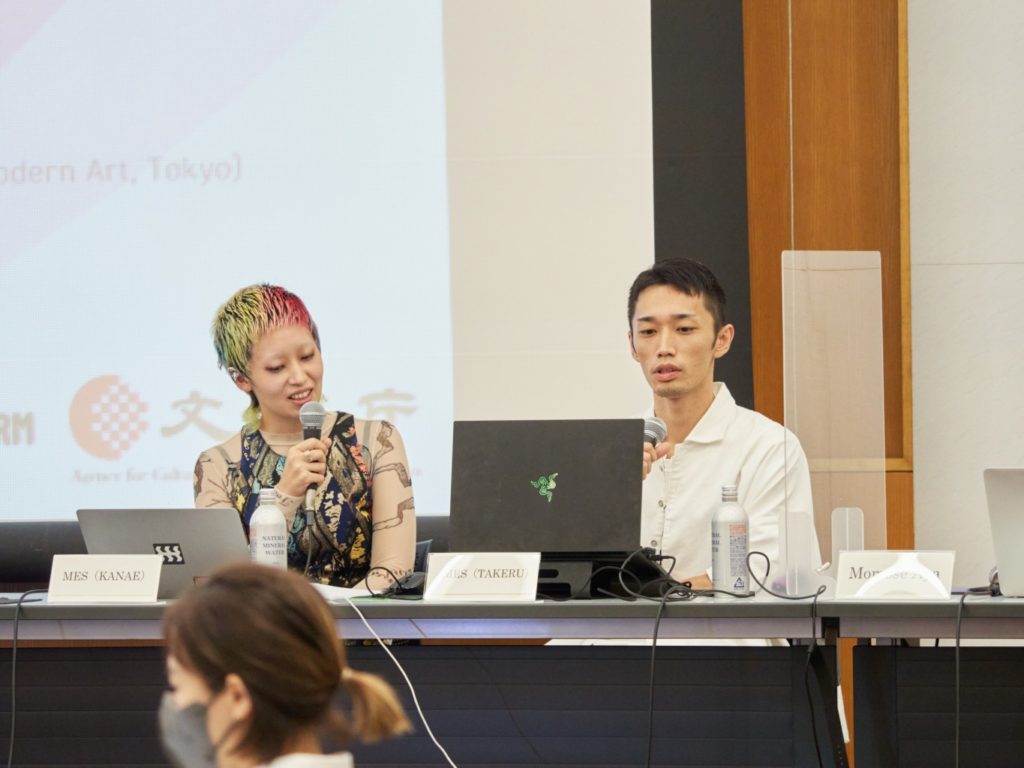
Artist duo bridging club culture and contemporary art
MES (Artist duo)
Tanikawa Kanae and Arai Takeru formed the artist duo MES in 2015 while still in college. Exploring the theme of connecting with other people and places on a personal level, they transcend the manners and institutions of their field while engaging in cross-disciplinary activities spanning fields including art, music, and club culture.
In 2018, after the club they were based in was raided by police during an urban development push, MES began using laser lighting on the streets of Shibuya, employing laser beams to write messages on the exterior walls of buildings. In May 2020, after Japan’s first pandemic-induced state of emergency was declared, they presented “DISTANCE OF RESISTANCE,” a laser work in the shape of a raised middle finger projected onto the empty National Diet building—a project that was turned into an exhibition the following year. The two artists view this laser-lighting series as part of the genealogy of action and activism, rather than as graffiti or vandalism. They are conscious of the fact that contexts change with time and circumstances, and said they hope to eventually exhibit their work in different environments and in other countries as well.
The duo also touched on “SA-I,” a gender-themed work presented in 2021 at a closed-down public bathhouse as part of the Reborn Art Festival in Ishinomaki, Miyagi Prefecture. With a complex composition highlighting the pandemic-afflicted Tokyo Olympics and the 10th anniversary of the Great East Japan earthquake, the work used thermal imaging cameras to visualize messages written on seawalls and bodies using materials that undergo thermal changes.
Using disappearing media such as lasers and thermal imaging, MES said that they hope to continue creating intimate works that emphasize transience. “We believe that by tackling areas that contemporary art history has ignored, we can for the first time confront macro-level history and social phenomena from an appropriate distance.” (MES)
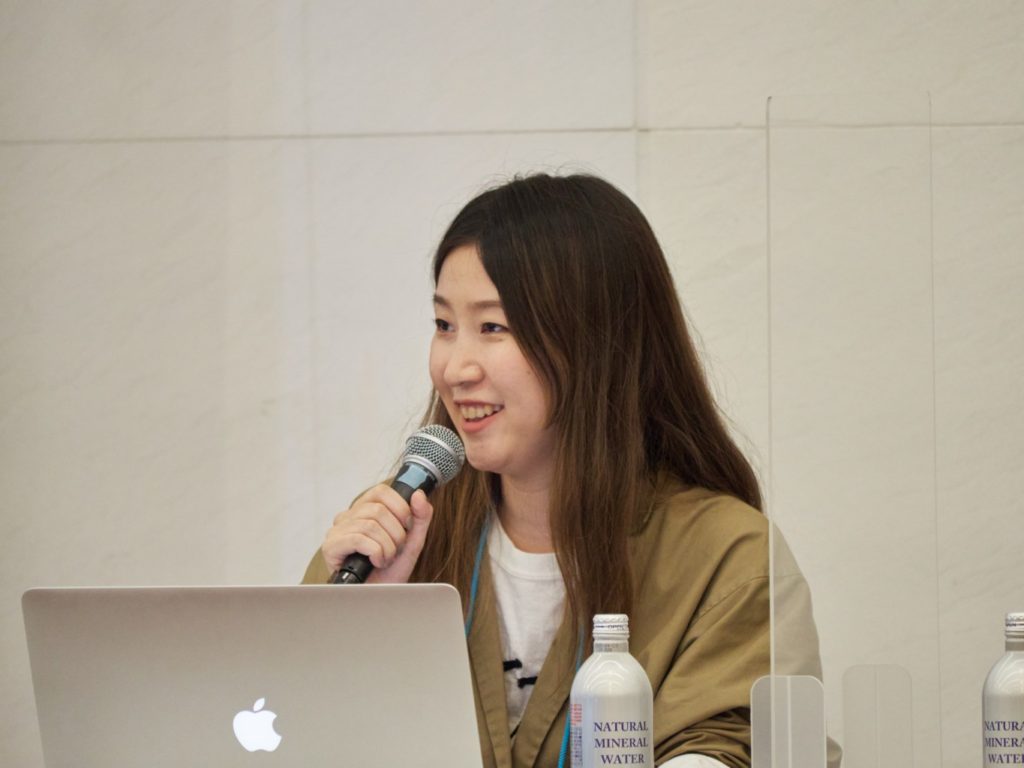
On talking about multi-layered bodies
Momose Aya (Artist)
Momose Aya, who depicts the multilayered nature of communication with the other through video and performance works, spoke about the transition of her interests in both her artwork and her life. Her video work “An Interview with Mr. Kinoshita: Detaching the Voice” (2013), based on a discussion with a Mr. Kinoshita, who was born with a hearing impairment, reveals the complex layers of voice and body. Since her stay in New York in 2019, where she was exposed to the resistance activities of minorities, Momose’s interests have expanded to issues of her own sexuality, desire, and gender, resulting in the works “Jokanaan” (2019) and “Love Condition” (2020). And through the production of “Flos Pavonis” (2021), which was inspired by the news that a law banning abortion had been passed in Poland during the pandemic, she has developed a new interest in the state and the body.
Having experienced the Covid-19 pandemic, in which contact with others was prohibited by the state and the social norm of family was reinforced, she said her current interest lies in “slipping away from the body registered by the state, and living and creating as a minimal form of anarchism.” Momose, for whom life and the creation of art are of equal value, also touched on her own lifestyle with two partners, describing it as resistance against the “ideology of romantic love” that espouses “meeting someone you’re destined to be with, marrying them and raising their children.” In addition, she stated that the idea of “relationship anarchy,” in which social labels are not allowed to control one’s relationships, inspires her work and life. “We don’t seek the approval of the state, don’t own anyone, and aren’t owned by anyone. Is it still possible to be together?” (Momose)
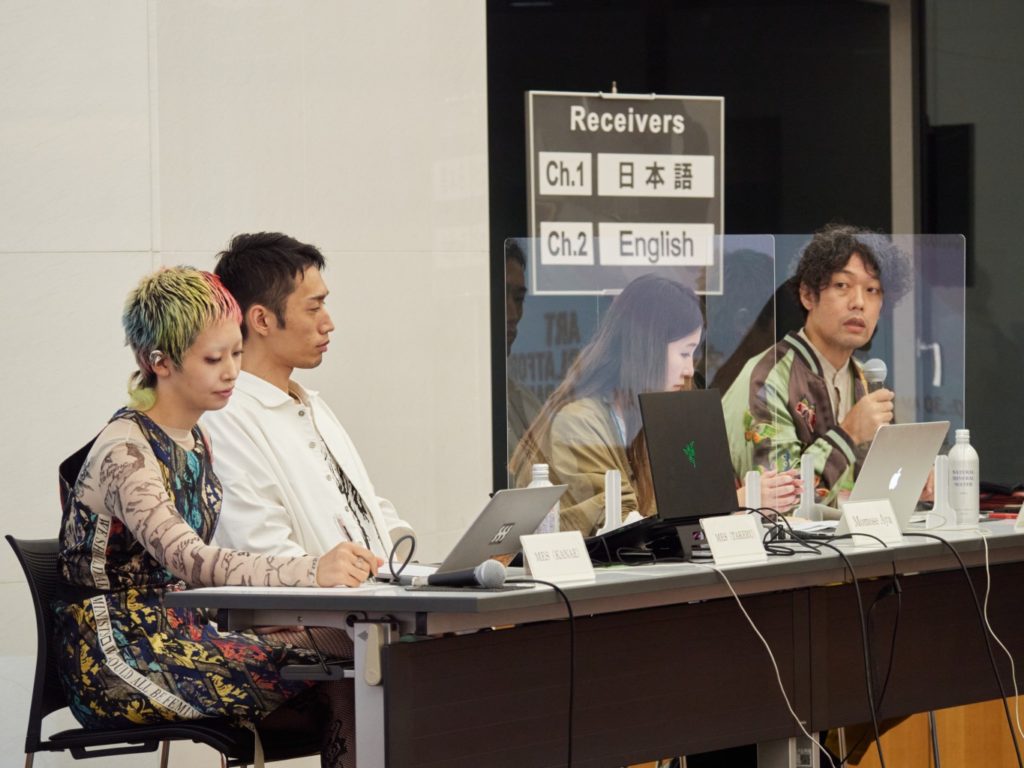
Discussion
At the beginning of the discussion, moderator Nariai Hajime remarked, “One thing all four of the participating artists have in common is that they draw on their personal, non-generalizable lives and interests in their work, juxtaposing them with larger social issues.” During the discussion, the artists exchanged opinions on the relationship between the individual and society, using terms such as privacy, participation, minority, activism, social change, and identity, but all of them indicated a strong reluctance to being categorized or symbolized according to their attributes—something that also applies to the others who appear in their works. Momose’s words, “Do you speak in the first person, or do you say ‘We’? I always say ‘I’ when creating my works. Something very personal can come across as something universal to someone else,” seem apt to describe the artistic practice of all the workshop speakers on this day. While sustainability and diversity are being held up as the goals for future society, Tanikawa of MES pointed out that “there are people who are being forced to confront their identities, and the fact that this has become an issue that merits serious consideration is in itself something that I feel uncomfortable about.” Her words evoked an ideal society of the future where people are allowed to exist as individuals. The words and works of the artists, who create their art as individuals and acknowledge each other’s individuality, made for a session that afforded both the participants and moderators with a great many insights.
Translated by Ilmari Saarinen
INFORMATION
4th Bunka-cho Contemporary Art Workshop
Date: 2022.9. 23 – 24 (Day 2)
Venue: Zoom Webinar (Aichi Arts Center)
Organizer: Bunka-cho
Photo: sato takuto


